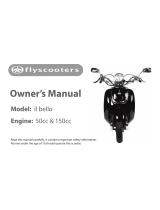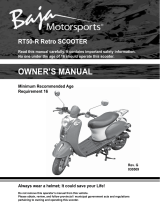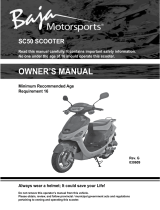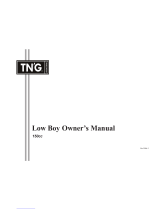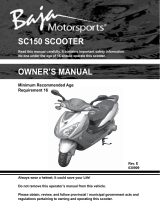Page is loading ...

PANTONE285CVC
VP125
OWNER’S MANUAL
16P-F8199-E1
Read this manual carefully before operating this vehicle.

EAU26945
Read this manual carefully before operating this vehicle. This manual should stay with this vehicle if it is sold.
DECLARATION of CONFORMITY
General manager of quality assurance div.
1
Version up the norm of EN60950 to EN60950-1
To change company name
27 Feb. 2006
1 Mar. 2007
2
3
Revision record
No. Contents Date
To change contact person and integrate type-designation. 9 Jun. 2005
Date of issue: 1 Aug. 2002
Place of issue: Shizuoka, Japan
R&TTE Directive(1999/5/EC)
EN300 330-2 v1.1.1(2001-6), EN60950-1(2001)
Two or Three-Wheel Motor Vehicles Directive(97/24/EC: Chapter 8, EMC)
is in compliance with following norm(s) or documents:
Kind of equipment: IMMOBILIZER
Type-designation: 5SL-00
Hereby declare that the product:
Company: YAMAHA MOTOR ELECTRONICS CO., LTD.
Address: 1450-6, Mori, Mori-Machi, Shuchi-gun, Shizuoka-Ken, 437-0292 Japan
We
U16PE1E0.book Page 1 Monday, July 28, 2008 9:57 AM

INTRODUCTION
EAU10113
Welcome to the Yamaha world of motorcycling!
As the owner of the VP125, you are benefiting from Yamaha’s vast experience and newest technology regarding the design
and manufacture of high-quality products, which have earned Yamaha a reputation for dependability.
Please take the time to read this manual thoroughly, so as to enjoy all advantages of your VP125. The Owner’s Manual does
not only instruct you in how to operate, inspect and maintain your scooter, but also in how to safeguard yourself and others
from trouble and injury.
In addition, the many tips given in this manual will help keep your scooter in the best possible condition. If you have any fur-
ther questions, do not hesitate to contact your Yamaha dealer.
The Yamaha team wishes you many safe and pleasant rides. So, remember to put safety first!
Yamaha continually seeks advancements in product design and quality. Therefore, while this manual contains the most cur-
rent product information available at the time of printing, there may be minor discrepancies between your scooter and this
manual. If there is any question concerning this manual, please consult a Yamaha dealer.
WARNING
EWA12411
Please read this manual carefully and completely before operating this scooter.
U16PE1E0.book Page 1 Monday, July 28, 2008 9:57 AM

IMPORTANT MANUAL INFORMATION
EAU10132
Particularly important information is distinguished in this manual by the following notations:
This is the safety alert symbol. It is used to alert you to potential personal injury
hazards. Obey all safety messages that follow this symbol to avoid possible injury
or death.
A WARNING indicates a hazardous situation which, if not avoided, could result in
death or serious injury.
A NOTICE indicates special precautions that must be taken to avoid damage to the
vehicle or other property.
A TIP provides key information to make procedures easier or clearer.
WARNING
NOTICE
TIP
U16PE1E0.book Page 1 Monday, July 28, 2008 9:57 AM

IMPORTANT MANUAL INFORMATION
EAUM1010
VP125
OWNER’S MANUAL
©2008 by MBK INDUSTRIE
1st edition, July 2008
All rights reserved
Any reprinting or unauthorized use
without the written permission of
MBK INDUSTRIE
is expressly prohibited.
Printed in France.
U16PE1E0.book Page 2 Monday, July 28, 2008 9:57 AM

TABLE OF CONTENTS
SAFETY INFORMATION ..................1-1
Further safe-riding points ................1-5
DESCRIPTION ..................................2-1
Left view ..........................................2-1
Right view........................................2-2
Controls and instruments.................2-3
INSTRUMENT AND CONTROL
FUNCTIONS .......................................3-1
Immobilizer system .........................3-1
Main switch/steering lock ................3-2
Indicator and warning lights ............3-3
Speedometer ..................................3-4
Fuel gauge ......................................3-5
Coolant temperature gauge ............3-5
Multi-function display ......................3-5
Handlebar switches ........................3-8
Front brake lever ............................3-9
Rear brake lever .............................3-9
Fuel tank cap ................................3-10
Fuel ...............................................3-10
Catalytic converters ......................3-12
Seat ..............................................3-12
Storage compartments .................3-13
Windshield ....................................3-14
Adjusting the shock absorber
assemblies ................................3-15
Carrier ...........................................3-16
Luggage hook ...............................3-16
Sidestand ......................................3-16
Ignition circuit cut-off system ........ 3-17
FOR YOUR SAFETY –
PRE-OPERATION CHECKS ............. 4-1
OPERATION AND IMPORTANT
RIDING POINTS................................. 5-1
Starting the engine ......................... 5-1
Starting off ...................................... 5-2
Acceleration and deceleration ........ 5-2
Braking ........................................... 5-3
Tips for reducing fuel
consumption ............................... 5-3
Engine break-in ..............................5-4
Parking ........................................... 5-4
PERIODIC MAINTENANCE AND
ADJUSTMENT ................................... 6-1
Owner’s tool kit ............................... 6-1
Periodic maintenance and
lubrication chart .......................... 6-2
Removing and installing cowlings
and panels .................................. 6-6
Checking the spark plug ................. 6-7
Engine oil ....................................... 6-8
Final transmission oil .................... 6-11
Coolant ......................................... 6-12
Air filter and V-belt case air filter
elements ................................... 6-13
Checking the throttle cable free
play ........................................... 6-14
Valve clearance ........................... 6-15
Tires ............................................. 6-15
Cast wheels ................................. 6-17
Front and rear brake lever free
play ........................................... 6-17
Checking the front and rear brake
pads .......................................... 6-18
Checking the brake fluid level ...... 6-18
Changing the brake fluid .............. 6-19
Checking and lubricating the
cables ....................................... 6-20
Checking and lubricating the
throttle grip and cable ............... 6-20
Lubricating the front and rear
brake levers .............................. 6-20
Checking and lubricating the
centerstand and sidestand ....... 6-21
Checking the front fork ................. 6-21
Checking the steering .................. 6-22
Checking the wheel bearings ....... 6-22
Battery ......................................... 6-23
Replacing the fuses ..................... 6-24
Replacing a headlight bulb .......... 6-25
Replacing a front turn signal light
bulb ........................................... 6-27
Replacing a tail/brake light bulb or
a rear turn signal light bulb ....... 6-27
Replacing the license plate light
bulb ........................................... 6-28
Replacing an auxiliary light
bulb ........................................... 6-28
U16PE1E0.book Page 1 Monday, July 28, 2008 9:57 AM

TABLE OF CONTENTS
Troubleshooting ............................6-29
Troubleshooting charts .................6-30
SCOOTER CARE AND STORAGE ...7-1
Care ................................................7-1
Storage ...........................................7-3
SPECIFICATIONS .............................8-1
CONSUMER INFORMATION.............9-1
Identification numbers ....................9-1
U16PE1E0.book Page 2 Monday, July 28, 2008 9:57 AM

1-1
1
SAFETY INFORMATION
EAU10263
Be a Responsible Owner
As the vehicle’s owner, you are respon-
sible for the safe and proper operation
of your scooter.
Scooters are single-track vehicles.
Their safe use and operation are de-
pendent upon the use of proper riding
techniques as well as the expertise of
the operator. Every operator should
know the following requirements before
riding this scooter.
He or she should:
● Obtain thorough instructions from
a competent source on all aspects
of scooter operation.
● Observe the warnings and mainte-
nance requirements in this Own-
er’s Manual.
● Obtain qualified training in safe
and proper riding techniques.
● Obtain professional technical ser-
vice as indicated in this Owner’s
Manual and/or when made neces-
sary by mechanical conditions.
Safe Riding
Perform the pre-operation checks each
time you use the vehicle to make sure it
is in safe operating condition. Failure to
inspect or maintain the vehicle properly
increases the possibility of an accident
or equipment damage. See page 4-1
for a list of pre-operation checks.
● This scooter is designed to carry
the operator and a passenger.
● The failure of motorists to detect
and recognize scooters in traffic is
the predominating cause of auto-
mobile/scooter accidents. Many
accidents have been caused by an
automobile driver who did not see
the scooter. Making yourself con-
spicuous appears to be very effec-
tive in reducing the chance of this
type of accident.
Therefore:
• Wear a brightly colored jacket.
• Use extra caution when you are
approaching and passing
through intersections, since in-
tersections are the most likely
places for scooter accidents to
occur.
• Ride where other motorists can
see you. Avoid riding in another
motorist’s blind spot.
● Many accidents involve inexperi-
enced operators. In fact, many op-
erators who have been involved in
accidents do not even have a cur-
rent driver’s license.
• Make sure that you are qualified
and that you only lend your
scooter to other qualified opera-
tors.
• Know your skills and limits.
Staying within your limits may
help you to avoid an accident.
• We recommend that you prac-
tice riding your scooter where
there is no traffic until you have
become thoroughly familiar with
the scooter and all of its con-
trols.
● Many accidents have been caused
by error of the scooter operator. A
typical error made by the operator
is veering wide on a turn due to ex-
U16PE1E0.book Page 1 Monday, July 28, 2008 9:57 AM

SAFETY INFORMATION
1-2
1
cessive speed or undercornering
(insufficient lean angle for the
speed).
• Always obey the speed limit and
never travel faster than warrant-
ed by road and traffic conditions.
• Always signal before turning or
changing lanes. Make sure that
other motorists can see you.
● The posture of the operator and
passenger is important for proper
control.
• The operator should keep both
hands on the handlebar and
both feet on the operator foot-
rests during operation to main-
tain control of the scooter.
• The passenger should always
hold onto the operator, the seat
strap or grab bar, if equipped,
with both hands and keep both
feet on the passenger footrests.
Never carry a passenger unless
he or she can firmly place both
feet on the passenger footrests.
● Never ride under the influence of
alcohol or other drugs.
● This scooter is designed for on-
road use only. It is not suitable for
off-road use.
Protective apparel
The majority of fatalities from scooter
accidents are the result of head inju-
ries. The use of a safety helmet is the
single most critical factor in the preven-
tion or reduction of head injuries.
● Always wear an approved helmet.
● Wear a face shield or goggles.
Wind in your unprotected eyes
could contribute to an impairment
of vision that could delay seeing a
hazard.
● The use of a jacket, substantial
shoes, trousers, gloves, etc., is ef-
fective in preventing or reducing
abrasions or lacerations.
● Never wear loose-fitting clothes,
otherwise they could catch on the
control levers or wheels and cause
injury or an accident.
● Always wear protective clothing
that covers your legs, ankles, and
feet. The engine or exhaust sys-
tem become very hot during or af-
ter operation and can cause burns.
● A passenger should also observe
the above precautions.
Avoid Carbon Monoxide Poisoning
All engine exhaust contains carbon
monoxide, a deadly gas. Breathing car-
bon monoxide can cause headaches,
dizziness, drowsiness, nausea, confu-
sion, and eventually death.
Carbon Monoxide is a colorless, odor-
less, tasteless gas which may be
present even if you do not see or smell
any engine exhaust. Deadly levels of
carbon monoxide can collect rapidly
and you can quickly be overcome and
unable to save yourself. Also, deadly
levels of carbon monoxide can linger
for hours or days in enclosed or poorly
ventilated areas. If you experience any
symptoms of carbon monoxide poison-
ing, leave the area immediately, get
fresh air, and SEEK MEDICAL TREAT-
MENT.
● Do not run engine indoors. Even if
you try to ventilate engine exhaust
with fans or open windows and
doors, carbon monoxide can rap-
idly reach dangerous levels.
U16PE1E0.book Page 2 Monday, July 28, 2008 9:57 AM

SAFETY INFORMATION
1-3
1
● Do not run engine in poorly venti-
lated or partially enclosed areas
such as barns, garages, or car-
ports.
● Do not run engine outdoors where
engine exhaust can be drawn into
a building through openings such
as windows and doors.
Loading
Adding accessories or cargo to your
scooter can adversely affect stability
and handling if the weight distribution of
the scooter is changed. To avoid the
possibility of an accident, use extreme
caution when adding cargo or accesso-
ries to your scooter. Use extra care
when riding a scooter that has added
cargo or accessories. Here, along with
the information about accessories be-
low, are some general guidelines to fol-
low if loading cargo to your scooter:
The total weight of the operator, pas-
senger, accessories and cargo must
not exceed the maximum load limit.
Operation of an overloaded vehicle
could cause an accident.
When loading within this weight limit,
keep the following in mind:
● Cargo and accessory weight
should be kept as low and close to
the scooter as possible. Securely
pack your heaviest items as close
to the center of the vehicle as pos-
sible and make sure to distribute
the weight as evenly as possible
on both sides of the scooter to min-
imize imbalance or instability.
● Shifting weights can create a sud-
den imbalance. Make sure that ac-
cessories and cargo are securely
attached to the scooter before
riding. Check accessory mounts
and cargo restraints frequently.
• Properly adjust the suspension
for your load (suspension-ad-
justable models only), and
check the condition and pres-
sure of your tires.
• Never attach any large or heavy
items to the handlebar, front
fork, or front fender. Such items
can create unstable handling or
a slow steering response.
● This vehicle is not designed to
pull a trailer or to be attached to
a sidecar.
Genuine Yamaha Accessories
Choosing accessories for your vehicle
is an important decision. Genuine
Yamaha accessories, which are avail-
able only from a Yamaha dealer, have
been designed, tested, and approved
by Yamaha for use on your vehicle.
Many companies with no connection to
Yamaha manufacture parts and acces-
sories or offer other modifications for
Yamaha vehicles. Yamaha is not in a
position to test the products that these
aftermarket companies produce.
Therefore, Yamaha can neither en-
dorse nor recommend the use of ac-
cessories not sold by Yamaha or
modifications not specifically recom-
mended by Yamaha, even if sold and
installed by a Yamaha dealer.
Maximum load:
185 kg (408 lb)
U16PE1E0.book Page 3 Monday, July 28, 2008 9:57 AM

SAFETY INFORMATION
1-4
1
Aftermarket Parts, Accessories, and
Modifications
While you may find aftermarket prod-
ucts similar in design and quality to
genuine Yamaha accessories, recog-
nize that some aftermarket accessories
or modifications are not suitable be-
cause of potential safety hazards to you
or others. Installing aftermarket prod-
ucts or having other modifications per-
formed to your vehicle that change any
of the vehicle’s design or operation
characteristics can put you and others
at greater risk of serious injury or death.
You are responsible for injuries related
to changes in the vehicle.
Keep the following guidelines in mind,
as well as those provided under “Load-
ing” when mounting accessories.
● Never install accessories or carry
cargo that would impair the perfor-
mance of your scooter. Carefully
inspect the accessory before using
it to make sure that it does not in
any way reduce ground clearance
or cornering clearance, limit sus-
pension travel, steering travel or
control operation, or obscure lights
or reflectors.
• Accessories fitted to the handle-
bar or the front fork area can
create instability due to improper
weight distribution or aerody-
namic changes. If accessories
are added to the handlebar or
front fork area, they must be as
lightweight as possible and
should be kept to a minimum.
• Bulky or large accessories may
seriously affect the stability of
the scooter due to aerodynamic
effects. Wind may attempt to lift
the scooter, or the scooter may
become unstable in cross
winds. These accessories may
also cause instability when
passing or being passed by
large vehicles.
• Certain accessories can dis-
place the operator from his or
her normal riding position. This
improper position limits the free-
dom of movement of the opera-
tor and may limit control ability,
therefore, such accessories are
not recommended.
● Use caution when adding electri-
cal accessories. If electrical acces-
sories exceed the capacity of the
scooter’s electrical system, an
electric failure could result, which
could cause a dangerous loss of
lights or engine power.
Aftermarket Tires and Rims
The tires and rims that came with your
scooter were designed to match the
performance capabilities and to provide
the best combination of handling, brak-
ing, and comfort. Other tires, rims, siz-
es, and combinations may not be
appropriate. Refer to page 6-15 for tire
specifications and more information on
replacing your tires.
U16PE1E0.book Page 4 Monday, July 28, 2008 9:57 AM

SAFETY INFORMATION
1-5
1
EAU10372
Further safe-riding points
● Be sure to signal clearly when
making turns.
● Braking can be extremely difficult
on a wet road. Avoid hard braking,
because the scooter could slide.
Apply the brakes slowly when
stopping on a wet surface.
● Slow down as you approach a cor-
ner or turn. Once you have com-
pleted a turn, accelerate slowly.
● Be careful when passing parked
cars. A driver might not see you
and open a door in your path.
● Railroad crossings, streetcar rails,
iron plates on road construction
sites, and manhole covers be-
come extremely slippery when
wet. Slow down and cross them
with caution. Keep the scooter up-
right, otherwise it could slide out
from under you.
● The brake pads could get wet
when you wash the scooter. After
washing the scooter, check the
brakes before riding.
● Always wear a helmet, gloves,
trousers (tapered around the cuff
and ankle so they do not flap), and
a bright colored jacket.
● Do not carry too much luggage on
the scooter. An overloaded scoot-
er is unstable. Use a strong cord to
secure any luggage to the carrier
(if equipped). A loose load will af-
fect the stability of the scooter and
could divert your attention from the
road. (See page 1-1.)
U16PE1E0.book Page 5 Monday, July 28, 2008 9:57 AM

DESCRIPTION
2-1
2
EAU32220
Left view
1
2345879
6
1. Rear storage compartment (page 3-13)
2. Shock absorber assembly spring preload adjusting ring (page 3-15)
3. Final transmission oil filler cap (page 6-11)
4. Air filter element (page 6-13)
5. V-belt case air filter element (page 6-13)
6. Engine oil filter element (page 6-8)
7. Sidestand (page 3-16, 6-21)
8. Coolant level check window (page 6-12)
9. Front brake pads (page 6-18)
U16PE1E0.book Page 1 Monday, July 28, 2008 9:57 AM

DESCRIPTION
2-2
2
EAU32230
Right view
213 4
5678
1. Grab bar (page 5-2)
2. Main fuse/fuse box (page 6-24)
3. Battery (page 6-23)
4. Coolant reservoir cap (page 6-12)
5. Fuel tank cap (page 3-10)
6. Engine oil filler cap (page 6-8)
7. Centerstand (page 6-21)
8. Rear brake pads (page 6-18)
U16PE1E0.book Page 2 Monday, July 28, 2008 9:57 AM

DESCRIPTION
2-3
2
EAU10430
Controls and instruments
12 3456 789
1. Rear brake lever (page 3-9)
2. Left handlebar switches (page 3-8)
3. Front storage compartment (page 3-13)
4. Speedometer/Multi-function display (page 3-4/page 3-5)
5. Luggage hook (page 3-16)
6. Main switch/steering lock (page 3-2)
7. Right handlebar switch (page 3-8)
8. Throttle grip (page 6-14)
9. Front brake lever (page 3-9)
U16PE1E0.book Page 3 Monday, July 28, 2008 9:57 AM

INSTRUMENT AND CONTROL FUNCTIONS
3-1
3
EAU10974
Immobilizer system
This vehicle is equipped with an immo-
bilizer system to help prevent theft by
re-registering codes in the standard
keys. This system consists of the fol-
lowing.
● a code re-registering key (with a
red bow)
● two standard keys (with a black
bow) that can be re-registered with
new codes
● a transponder (which is installed in
the code re-registering key)
● an immobilizer unit
● an ECU (Electronic Control Unit)
● an immobilizer system indicator
light (See page 3-3.)
The key with the red bow is used to reg-
ister codes in each standard key. Since
re-registering is a difficult process, take
the vehicle along with all three keys to
a Yamaha dealer to have them re-reg-
istered. Do not use the key with the red
bow for driving. It should only be used
for re-registering the standard keys. Al-
ways use a standard key for driving.
NOTICE
ECA11821
● DO NOT LOSE THE CODE RE-
REGISTERING KEY! CONTACT
YOUR DEALER IMMEDIATELY
IF IT IS LOST! If the code re-reg-
istering key is lost, registering
new codes in the standard keys
is impossible. The standard
keys can still be used to start
the vehicle, however if code re-
registering is required (i.e., if a
new standard key is made or all
keys are lost) the entire immobi-
lizer system must be replaced.
Therefore, it is highly recom-
mended to use either standard
key and keep the code re-regis-
tering key in a safe place.
● Do not submerse any key in wa-
ter.
● Do not expose any key to exces-
sively high temperatures.
● Do not place any key close to
magnets (this includes, but not
limited to, products such as
speakers, etc.).
● Do not place items that transmit
electrical signals close to any
key.
● Do not place heavy items on any
key.
● Do not grind any key or alter its
shape.
● Do not disassemble the plastic
part of any key.
● Do not put two keys of any im-
mobilizer system on the same
key ring.
● Keep the standard keys as well
as keys of other immobilizer
systems away from this vehi-
cle’s code re-registering key.
1. Code re-registering key (red bow)
2. Standard keys (black bow)
U16PE1E0.book Page 1 Monday, July 28, 2008 9:57 AM

INSTRUMENT AND CONTROL FUNCTIONS
3-2
3
● Keep other immobilizer system
keys away from the main switch
as they may cause signal inter-
ference.
EAU10471
Main switch/steering lock
The main switch/steering lock controls
the ignition and lighting systems, and is
used to lock the steering.
TIP
Be sure to use the standard key (black
bow) for regular use of the vehicle. To
minimize the risk of losing the code re-
registering key (red bow), keep it in a
safe place and only use it for code re-
registering.
EAU34121
ON
All electrical circuits are supplied with
power; the meter lighting, taillight, li-
cense plate light and auxiliary lights
come on, and the engine can be start-
ed. The key cannot be removed.
TIP
The headlights come on automatically
when the engine is started and stay on
until the key is turned to “OFF” or the
sidestand is moved down.
EAU10661
OFF
All electrical systems are off. The key
can be removed.
WARNING
EWA10061
Never turn the key to “OFF” or
“LOCK” while the vehicle is moving.
Otherwise the electrical systems will
be switched off, which may result in
loss of control or an accident.
P
U
S
H
O
P
E
N
O
F
F
O
N
L
O
C
K
I
G
N
I
T
I
O
N
ZAUM0696
U16PE1E0.book Page 2 Monday, July 28, 2008 9:57 AM

INSTRUMENT AND CONTROL FUNCTIONS
3-3
3
EAU10681
LOCK
The steering is locked, and all electrical
systems are off. The key can be re-
moved.
To lock the steering
1. Turn the handlebars all the way to
the left.
2. Push the key in from the “OFF” po-
sition, and then turn it to “LOCK”
while still pushing it.
3. Remove the key.
To unlock the steering
Push the key in, and then turn it to
“OFF” while still pushing it.
EAU11003
Indicator and warning lights
EAU11030
Turn signal indicator lights “”
and “”
The corresponding indicator light flash-
es when the turn signal switch is
pushed to the left or right.
EAU11080
High beam indicator light “”
This indicator light comes on when the
high beam of the headlight is switched
on.
EAU11482
Engine trouble warning light “”
This warning light comes on if a prob-
lem is detected in the electrical circuit
monitoring the engine. If this occurs,
have a Yamaha dealer check the self-
diagnosis system.
The electrical circuit of the warning light
can be checked by turning the key to
“ON”. If the warning light does not come
on for a few seconds, then go off, have
a Yamaha dealer check the electrical
circuit.
EAU38911
Immobilizer system indicator light
The electrical circuit of the indicator
light can be checked by turning the key
to “ON”.
If the indicator light does not come on
for a few seconds, then go off, have a
Yamaha dealer check the electrical cir-
cuit.
When the key is turned to “OFF” and 30
seconds have passed, the indicator
light will start flashing indicating the im-
mobilizer system is enabled. After 24
hours have passed, the indicator light
will stop flashing, however the immobi-
lizer system is still enabled.
1. High beam indicator light “”
2. Left turn signal indicator light “”
3. Immobilizer system indicator light
4. Right turn signal indicator light “”
5. Engine trouble warning light “”
12 3 45
ZAUM0697
U16PE1E0.book Page 3 Monday, July 28, 2008 9:57 AM

INSTRUMENT AND CONTROL FUNCTIONS
3-4
3
TIP
This model is also equipped with a self-
diagnosis device for the immobilizer
system. If the immobilizer system is not
working correctly, the indicator light will
start flashing a pattern when the key is
turned to “ON”. When this occurs, have
a Yamaha dealer check the self-diag-
nosis system. However, if the indicator
light slowly flashes five times, and then
quickly flashes two times repeatedly,
this error could be caused by signal in-
terference. If this occurs, try the follow-
ing.
1. Use the code re-registering key to
start the engine.
TIP
Make sure there are no other immobi-
lizer keys close to the main switch, and
do not keep more than one immobilizer
key on the same key ring! Immobilizer
system keys may cause signal interfer-
ence, which may prevent the engine
from starting.
2. If the engine starts, turn it off, and
try starting the engine with the
standard keys.
3. If one or both of the standard keys
do not start the engine, take the
vehicle, the code re-registering
key and both standard keys to a
Yamaha dealer and have the stan-
dard keys re-registered.
EAU11591
Speedometer
UK ONLY
The speedometer shows the riding
speed.
1. Speedometer
1. Speedometer
1
ZAUM0636
1
mph
0
10
20
30
40
50
60
70
80
90
100
ZAUM0637
U16PE1E0.book Page 4 Monday, July 28, 2008 9:57 AM

INSTRUMENT AND CONTROL FUNCTIONS
3-5
3
EAUM1471
Fuel gauge
The fuel gauge indicates the amount of
fuel in the fuel tank. The needle moves
towards “E” (Empty) as the fuel level
decreases. When the remaining fuel in
the tank reaches approximately 2.7 L
(0.72 US gal, 0.60 Imp.gal), the fuel
level warning light will come on and the
multi-function display will automatically
change to the “Trip/fuel” mode. (See
page 3-6.) If this occurs, refuel as soon
as possible.
TIP
Do not allow the fuel tank to empty itself
completely.
EAU12172
Coolant temperature gauge
With the key in the “ON” position, the
coolant temperature gauge indicates
the temperature of the coolant. The
coolant temperature varies with chang-
es in the weather and engine load. If
the needle reaches or enters the red
zone, stop the vehicle and let the en-
gine cool. (See page 6-30.)
NOTICE
ECA10021
Do not continue to operate the en-
gine if it is overheating.
EAUM2252
Multi-function display
WARNING
EWA12312
Be sure to stop the vehicle before
making any setting changes to the
multi-function display. Changing
settings while riding can distract the
operator and increase the risk of an
accident.
The multi-function display is equipped
with the following:
● an odometer (which shows the to-
tal distance traveled)
1. Fuel gauge
2. Fuel level warning light
1
2
ZAUM0638
1. Red zone
1
ZAUM0639
1. “MODE” button
2. Multi-function display
3. “SET” button
1
2
3
ZAUM0640
U16PE1E0.book Page 5 Monday, July 28, 2008 9:57 AM
/
